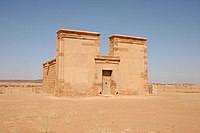Arnekhamani was a Nubian king of the Kushite Kingdom in the third century BC. The king is mainly known from his building activity at the Musawwarat es-Sufra temple complex. The main temple complex at this place was built by Arnekhamani, but was never finished. Most likely the king died before completing the temples.
| Arnekhamani | ||||||||||||||||||||||||||||||||||||||||||
|---|---|---|---|---|---|---|---|---|---|---|---|---|---|---|---|---|---|---|---|---|---|---|---|---|---|---|---|---|---|---|---|---|---|---|---|---|---|---|---|---|---|---|
![King Arnekhamani in Apedemak temple in Musawwarat es-sufra.[1][2][3]](http://upload.wikimedia.org/wikipedia/commons/thumb/d/d4/King_Arnekhamani.jpg/220px-King_Arnekhamani.jpg) | ||||||||||||||||||||||||||||||||||||||||||
| Pharaoh | ||||||||||||||||||||||||||||||||||||||||||
| Reign | late 3rd century BCE | |||||||||||||||||||||||||||||||||||||||||
| Predecessor | Shesepankhenamen Setepenre | |||||||||||||||||||||||||||||||||||||||||
| Successor | Arqamani | |||||||||||||||||||||||||||||||||||||||||
| ||||||||||||||||||||||||||||||||||||||||||
| Children | Arqamani | |||||||||||||||||||||||||||||||||||||||||
| Burial | Pyramid at Meroë (Beg. N. 53 (?)) | |||||||||||||||||||||||||||||||||||||||||
Three names are attested for Arnekhamani. His birth name was Arnekhamani, his throne name Kheperkare and his Horus name Kanakht Merymaat. His birthname includes several epithets that were changed in his reign. To the birth name was originally added beloved of Amun, later it was extended to may he live for ever, beloved of Amun. Finally it became may he live for ever, beloved of Isis. The Egyptian king Ptolemy IV Philopator (221–204 BC) is also called in his Egyptian name beloved of Isis and it seems possible that Arnekhamani's name was influenced by the name of the Egyptian king, providing a chronological fixpoint for the rule of Arnekhamani.[5]
In the temple complex are also mentioned the wife of Arnekhamani and his son. The name of the wife is not preserved. The son is called Arky and bears the title Priest of Isis, of Ipeber-ankh (Musawwarat es-Sufra). The latter might be identical with king Arqamani, who was then the successor of Arnekhamani.[6]
-
Temple of Apedemak in Musawwarat es-Sufra, built by Arnekhamani
-
King Arnekhamani (detail)
-
King Arnekhamani (portrait)
See also
editReferences
edit- ^ Wenig, Steffen (1999). Studien Zum Antiken Sudan: Akten Der 7. Internationalen Tagung Für Meroitische Forschungen Vom 14. Bis 19. September 1992 in Gosen/bei Berlin. Otto Harrassowitz Verlag. p. 631. ISBN 978-3-447-04139-3.
- ^ Lobban, Richard A. (2003). Historical Dictionary of Ancient and Medieval Nubia. Scarecrow Press. p. 46. ISBN 978-0-8108-6578-5.
- ^ Török, László; Torok, Laszlo (2011). Hellenizing Art in Ancient Nubia 300 B.C. - AD 250 and Its Egyptian Models: A Study in "Acculturation". BRILL. p. 432. ISBN 978-90-04-21128-5.
- ^ a b von Beckerath, Jürgen (1999). Handbuch der Ägyptischen Königsnamen (in German). Mainz am Rhein, Von Zabern. pp. 276–77. ISBN 3-8053-2591-6.
- ^ Török, László (1996). Fontes Historiae Nubiorum, Vol. II. Bergen. ISBN 8291626014., pp. 580-81
- ^ Török, László (1996). Fontes Historiae Nubiorum, Vol. II. Bergen. ISBN 8291626014., p. 582
- ^ Török, László (1996). Fontes Historiae Nubiorum, Vol. II. Bergen. ISBN 8291626014., p. 582



![Prince Arka, son of Arnekhamani, and possible future king Arqamani.[7]](http://upload.wikimedia.org/wikipedia/commons/thumb/6/67/Prince_Arka.jpg/116px-Prince_Arka.jpg)